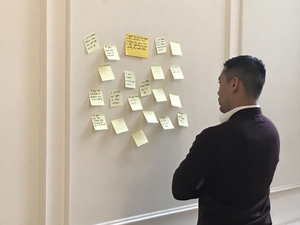Walking Brainstorm
This introvert-friendly brainstorming technique helps groups of any size to generate and build on each other's ideas in a silent but dynamic setting. As the participants keep moving, the exercise is ideal to kick-off a full day workshop or re-energize the group after lunch.
Goal
Crowdsource and build on each other's ideas without being distracted by personality types or disagreement.
Materials
Instructions
⚠️Before you start, make sure that there is enough space for the participants to walk around without stepping on each other.
📝Depending on the aim of the brainstorm, write either a topic or a question on the posters and spread them across the room. Make sure that there is sufficient space around each so that several participants can interact with them at the same time.
💡To inspire a wider range of ideas, you may vary the topic/ question on each poster.
⏱Set a timer between 3 and 15 minutes, depending on the group size and the complexity of the topic. Every participant receives a block of post-it notes and a marker.
🤫Silently, they walk around the room and share their ideas about the topics/ questions on the posters by sticking post-it notes on the poster. Remind participants to apply an open "yes, and" approach which means that they should build on each other's ideas and try to make them work instead of pointing out weak points or deal breakers.
👉Make sure that participants use one post-it note per idea. This will make it easier to remove redundant ideas and cluster the remaining.
🚀Before any brainstorming exercise, I always remind the participants that "Good ideas come from bad ideas as long as there are enough of them." (Seth Godin).
🏁When time is up, you can either debrief with the entire group or split the group into small teams who work on the different posters and then share their results with the group.
Tips for running this activity online
Background
The exercise is inspired by the "yes, and"-approach used in Improv' Theater.



Comments (0) (4.8 avg / 5 ratings)